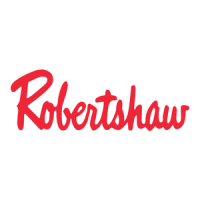
Do you have a question about the Robertshaw 9825i2 and is the answer not in the manual?
| Brand | Robertshaw |
|---|---|
| Model | 9825i2 |
| Category | Thermostat |
| Language | English |
Description of the main display screen elements and their functions.
Explanation of how each button (UP, DOWN, LEFT, RIGHT) operates.
Details on Off, Heat, Cool, Auto Changeover, and Emergency Heat modes.
How to temporarily override current temperature setpoints.
How to override setpoints for extended periods like vacations.
Choosing fan modes independently of heating or cooling cycles.
Using the programmed schedule to control fan operation.
Using the pre-programmed EnergyStar schedule for energy savings.
Navigating the Schedule Menu for programming functions.
Configuring the number of daily events for the program.
Choosing which days of the week to program.
Setting time, temperature, and fan for each program event.
Selecting Off, With Heating, or Independent Of Heating modes.
Setting humidity setpoint and preferred level.
Adjusting dew point to prevent condensation during humidification.
Selecting Off, With Cooling, or Independent Of Cooling modes.
Setting the humidity threshold for dehumidification.
Using the add-on cycle for duct-mounted dehumidifiers.
Degrees from setpoint for 1st stage equipment activation.
Degrees from 1st stage activation for 2nd stage equipment.
Timed delay between 1st and 2nd stage equipment activation.
Choosing local, remote, or averaged sensor for temperature control.
Setting deadband for Auto Changeover to control mode switching.
Enabling efficient recovery to reach setpoints by event times.
Setting Fahrenheit/Celsius units and showing setpoint on display.
Choosing display language for thermostat information.
Calibrating thermostat by offsetting temperature ±3°F or ±1.5°C.
Customizing main temperature display resolution (whole, half, tenths).
Setting reminders for filter, UV bulb, or humidifier pad maintenance.
Adjusting screen backlight brightness and contrast.
Configuring the type of equipment for the 1st stage heat.
Configuring 2nd stage heat/cool equipment and compressor type.
Determining how the fan operates with 2nd stage heating.
Setting minimum time between heating/cooling cycles to protect equipment.
Keeping the fan running after cooling cycle for efficiency.
Setting points to optimize heat pump and supplemental heat operation.
Setting reminders for system maintenance checks.
Defining maximum cooling and heating temperature limits.
Enabling automatic switching between heating and cooling modes.
Storing installing dealer's name and phone number.
Restoring thermostat to original factory default settings.
Enabling and disabling PIN protection for system settings.
Allowing users to modify Hold settings while locking other functions.
Enabling overall security lockout via a PIN.
Contacting support and recovering forgotten PINs.
Thermostat behavior during power outages and setting time/date.
Explanation of balance points for heat pump efficiency.
Understanding deadband for mode switching and EER™ energy saving.
Warning on changing installer settings and defining programming events.
Details on number of events per day and schedule customization.
Benefits and application of remote indoor sensors.
Installing and utilizing remote outdoor sensors for temperature monitoring.
Zoning with sensors and thermostat response to sensor failures.
Steps to perform a thermostat reset.
Tips for reducing energy costs using thermostat settings.
